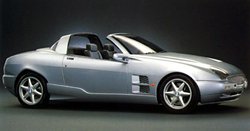De Tomaso Biguà

| |
| De Tomaso Biguà/Mangusta | |
|---|---|
| aka | Mangusta mk.II |
| Production | 1998-1999 (De Tomaso) 2000-2001 (Qvale) |
| Class | sports car |
| Body Style | 2-seater coupe/targa/convertible/C+C (configurable) |
| Length | 165 in (4191 mm) |
| Width | 75 in |
| Height | 50 in (1270 mm) |
| Wheelbase | 105 in (2667 mm) |
| Weight | 2530 lbs (1147.6 kg) |
| Transmission | Borg-Warner 5-speed manual 4-speed automatic |
| Engine | 4.6 litre Ford V8 |
| Power | 305 hp (224.5 kW) @ 6500 rpm 300 ft.lb (406.8 NM) @ 6500 rpm |
| Similar | Qvale Mangusta MG SV Porsche 911 |
| Designer | Marcello Gandini Alejandro de Tomaso |
The De Tomaso Biguà was a sports car produced by De Tomaso. At first, It was known as the Biguà but later renamed as the Mangusta in honor of the legendary original. Between 1998 and 1999 it was produced as a De Tomaso. From 2000 - 2001, however, it was badged as a Qvale.
Overview
Penned by Marcello Gandini and Alejandro de Tomaso, the Bigua was De Tomaso's replacement for its twenty year old Pantera. Introduced in 1996 at the Geneva Motor Show, the name was replaced with Mangusta during preproduction. It is powered by a 4.6 litre Ford V8, an engine also used in the Mustang. The double-overhead cam, all-alloy engine was capable of producing 305 hp. The vehicle can be opted with either a Borg-Warner 5-speed manual or a computer-controlled 4-speed automatic. Acceleration times were impressive, finishing 0-60 mph in just 4.2 seconds. Most prior DeTomaso models featured mid-engined designs; the Bigua, however, was front-engined. The Ford influence is not just mechanical, but aesthetically too. The instruments and other parts of the interior have taken styling cues from Ford and includes amenities such as ABS, climate control, CD sound system, power windows, locks, and leather seats. Production was expected to be in the neighborhood of 500 units per year.
Qvale Iteration
Although the new Mangusta was not very long, it was extremely wide and heavy. Its 2670mm wheelbase was also among the longest for a 2-seater. That enabled the big V8 to be positioned virtually completely behind the front axle and resulted in a perfect front-to-rear weight distribution.
The Mustang V8 delivered power linearly across the rev range rather than concentrated on the bottom end. Although the Mangusta was 100 kg lighter than a Mustang, it still weighed a rather hefty 1450 kg. The Borg-Warner 5-speed manual also deteriorated the performance by its widely separated ratios. Shift quality was not as good as European standard too. As a result, 0-60 mph required about 6 seconds.
Handling was pretty good. In terms of specifications, it was hard to be criticized: a very rigid chassis, 50-50 weight distribution, all double wishbones suspensions, grippy tires and strong Brembo brakes. It rode well yet provided excellent body control. There was no understeer expected for a front V8 sports car, just very neutral except coming near limit. There was power oversteering to play with. Braking was powerful and progressive. On the negative side, the Ford-sourced power steering was too light for European driving style, and lacked a sharp turn-in feeling. Otherwise, the Mangusta was well balanced and competent to drive fast without asking for too much effort and attention. It was not as focused or as exciting as many European sports cars, but Qvales’ eyes were always looking to the US market, where people required a bit more driving ease instead of driving fun.
Like the De Tomaso, the Qvale Mangusta's cabin and components was supplied by the Ford division Visteon with all the switch gears and equipment pre-installed. Door handles and other controls also came from Ford’s parts bin. Therefore, the interior looked very much like a Ford Mustang.
Qvales expected to produce 900 Mangustas in 2001, but that did not come true. Market reaction to the car was poor, probably due to its mild performance, weird look and cheap interior, or its general inability to match Porsche 911. In mid-2001, Qvale sold its sports car making business, including the Modena factory, to MG Rover. The latter reskinned and reengineered the Mangusta into MG SV (project X80), which was just another flop.
Configurable Top
Capitalizing on the popularity of the Mercedes-Benz SLK's folding metal roof, the Bigua/Mangusta featured a modular metal top design. The car can be configured as an open-topped targa, a convertible or a closed coupe at the push of a button. The middle panel can be removed (by hand) and the rear top and window can then be rotate down into the bodywork.
Photos
- Qvale-mangusta01.jpg
2001 Qvale Mangusta
De Tomaso Modena S.p.A. car timeline, 1960s–2010s
| ||||||||||||||||||||||||||||||||||||||||||||||||||||||||||||||||||||||||||||||||||||||||||||||||||||||||||||||||||||||||||||||||||||||||||||||||||||||||||||||||||||||||||||||||||||||||||||||||||||||||||||||||||||||||||||||||||||||||||||||||||||||||||||||||||||||||||||||||||


